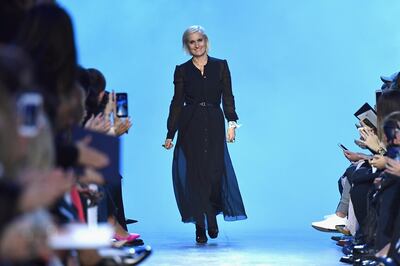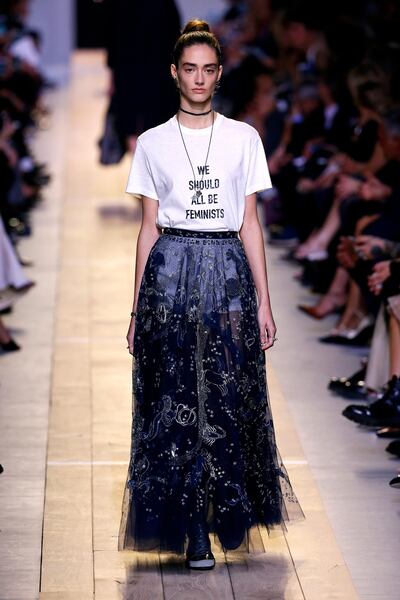One of the most talked about pieces from Dior's spring 2017 runway show was a simple white T-shirt emblazoned with the phrase "We should all be feminists". Inspired by Nigerian author Chimamanda Ngozi Adichie's essay and TEDx talk of the same name, the much-commented-upon tee was a seemingly innocuous, but undeniably canny statement from Dior's new creative director, Maria Grazia Chiuri, in her first show for a fashion house that, in its 70-year history, had previously only ever been headed by men.
This is the paradox that lies at the very heart of the fashion industry: for the best part of the past century, men have been almost exclusively responsible for dictating what women wear.
In the beginning, before ready-to-wear existed, new clothes meant a trip to a seamstress, who would run up dresses, bodices, skirts and bonnets to order. Though valued and skilled, these women were largely anonymous, and the focus was placed squarely on the wearer. That attitude began to shift slightly when Charles Frederick Worth opened his couture shop in Paris in the 1850s. He is now celebrated as the first male couturier, but at the time it was unheard of for a man to design for women, and his arrival caused considerable controversy.
As fashion historian and author E P Cutler explains: “In the beginning, it was a bit of a scandal to have a man fitting a woman. Touching and seeing her, in a manner of undress. But once Empress Eugénie, the wife of Napoleon III, became a Worth fan circa 1860, it became acceptable.”
Worth's arrival signified a change in thinking, and shifted focus onto the designer as well as the wearer. A few years later, fashion designers – as we understand the term today – began to emerge in earnest, and almost all were women. Jeanne Paquin opened her own couture house in Paris in 1890. Madeleine Vionnet followed, as did a certain Gabrielle "Coco" Chanel, Elsa Schiaparelli and Jeanne Lanvin. It was a golden age for female fashion designers.
Things changed again after the two world wars. Deep-seated ideas around traditional gender roles underwent a dramatic shift, and in the decade that followed, many of the old social mores no longer felt relevant. The idea of men designing for women became entirely socially acceptable, and by the mid-1950s, a tranche of young male designers appeared, eager to make their mark on women's fashion. Armed with new ideas and new silhouettes, Yves Saint Laurent, Karl Lagerfeld, Christian Dior, Hubert de Givenchy and Cristóbal Balenciaga started their careers creating clothes that seemed to focus more on idolising women than delivering any kind of practicality.

Dior led the way with his "New Look Revolution" of corset waists and huge skirts, which restricted women's movements and represented something of a step backwards. Nonetheless, the collections were massively successful, and male designers effectively took control of women's fashion.
Lagerfeld went on to head womenswear at both Chanel and Fendi (for 34 and 50 years and counting, respectively), while all designers for Yves Saint Laurent have been male. Burberry's womenswear is designed by Christopher Bailey and Bottega Veneta's by Tomas Maier. And so on and so forth.
Of course, that’s not to say that the industry is exclusively testosterone-driven. There have always been women at the helm of fashion houses, but they have, for the most part, been anomalies. Take Barbara Hulanicki and her iconic store Biba, which was at the very epicentre of London style in the swinging Sixties, or Miuccia Prada who has, since 1978, pioneered innumerable trends, first at Prada and later at Miu Miu.
Vivienne Westwood has an unwavering sense for counterculture, meshing music, punk and fashion. Donatella Versace was forced to take over her brother's company after his murder and, while embracing his legacy, has set about pushing boundaries, creating collections that are more sexually charged than anything Gianni ever designed. Hermès appointed Véronique Nichanian as head of menswear in 1988, although it then took another 27 years before Nadège Vanhee-Cybulski was appointed as creative director of womenswear. She is still the only woman ever to hold the role.
And then there is Sarah Burton, creative director of Alexander McQueen, and one of Cutler’s favourites. “It was poignant when she took the reins at Alexander McQueen after his suicide, but she has done such a breathtaking job, season after season, being true to McQueen’s legacy and vision, while merging it with her own.
“It is amazing when she allows McQueen’s more ferocious woman and her softer one to wrestle within her work. I think that is when she is at her best,” says Cutler.
And yet, these exceptions have only served to prove the rule – top positions at big fashion houses have always been reserved for men.
Until now.
The fashion industry is in the throes of an existentialist crisis, with several big-name fashion houses having lost their creative directors in recent times. Alber Elbaz exiting Lanvin, Riccardo Tisci leaving Givenchy and Raf Simons abandoning Dior are the major cases in point.
In response, and breaking with the traditions of the past 70 years, all three fashion houses employed women as their creative directors.
The 2016 appointment of Maria Grazia Chiuri at Christian Dior makes her the first woman ever to hold the role. She previously spent 10 years as joint creative director at Valentino, alongside Pierpaolo Piccioli, and prior to that was accessories designer for Fendi, part of the team that created the Baguette Bag. Faced with a legacy as rich as Dior’s, she could easily have stayed with the house’s trademark aesthetic of pretty femininity, but instead struck out on her own, with a debut collection that was savvy and empowered. It opened with shorn-haired model Ruth Bell in a pristine white fencing vest over knickerbockers, and continued with bar jackets over the aforementioned “feminist” T-shirts, which were, in turn, tucked into embellished tulle skirts. New, fresh and entirely updated, Chiuri’s vision for Dior is a house that speaks to the modern woman.

"Femininity isn't something that finished in the 1950s," she explained to Vogue ahead of her show. "It can be more contemporary. My reference is a modern woman, and my role has to be to understand women of the future."
Her subsequent collections – pre-fall 2017, autumn/winter 2017 and cruise 2018 – have continued on this track, with Chiuri clearly making efforts to understand what younger women want and, crucially, can afford. Her slogan T-shirts and chunky rings that spell out the words “J’adore” and “Dior” have become must-haves across all age groups.
It was also in 2016 that Lanvin named Bouchra Jarrar as its new creative director. At her appointment, she pointedly declared: "It's wonderful to arrive at Lanvin as a woman because it's a woman's story" – essentially aligning herself with the house's female founder. Unfortunately, her reign was short-lived and on July 6 she beat a hasty retreat from the fashion house, to be promptly replaced by Olivier Lapidus.
On a more positive note, this year saw the appointment of Clare Waight Keller as creative director of Givenchy. Poached from Chloé, she seems likely to bring a softer sensibility to the house than previous designers Riccardo Tisci and Alexander McQueen. More recently, Brioni has named Nina-Maria Nitsche as its new and first-ever female creative director.
The real question, of course, is whether it makes any difference, in terms of the actual clothes we wear, if they are designed by a man or a woman? "There is a strong myth that male designers don't consider the needs of women practically. First-wave feminism perpetuated that idea. In trying to fight the oversexualisation of women and their sidelined place in society, first-wave feminism threw fashion under the bus. The notion that women make softer clothes is not always true. I would not consider Vivienne Westwood's clothing to be 'soft' in the least, even though she is a woman," says Cutler.
“The complexity and power of women is vast. Besides, one person’s practical is not another’s. In New York, I wouldn’t think twice about wearing five-inch stilettos to run to the bodega. In that city at that time, I didn’t think there was anything impractical about that. In a high-powered business setting, I want armour – a fitted dress by Julianna Bass makes me feel [like a] boss. I feel comfortable being form-fitted to the millimetre in clothes when I am under pressure. Sometimes, a loose garment is more uncomfortable than a tight one. It all depends on time, place and person,” Cutler continues.
It is also important to remember that although the proliferation of female creative directors is encouraging from a social point of view, it is ultimately being driven by the bottom line.
“Bernard Arnault, CEO of LVMH, which now owns the couture division of Christian Dior and Givenchy, is one of the most brilliant business minds. People are getting excited and inspired about women helming these major couture houses; and that means revenue. Buying those brands now means supporting economically those creative directors and the brands they oversee. What’s good for women is good for business,” says Cutler.
There is one other, slightly less empowering possibility. Michelle Ryan and Alex Haslam of the School of Psychology at the University of Exeter have proposed a theory called the Glass Cliff, which suggests that when businesses are going through rocky times, women are more likely to be appointed to positions of power – the idea being that they are somehow more expendable than their male counterparts. Jarrar’s unexpected exit may support this theory.
Given the tumultuousness of the fashion industry today, where brands operate in an increasingly competitive landscape, with business models disrupted by digitalisation and initiatives such as see-now, buy-now, not to mention softening economies in many parts of the world, there is the unwelcome possibility that the likes of Chiuri and Waight Keller are more like sacrificial lambs than feminist revolutionaries.
Only time will tell.






